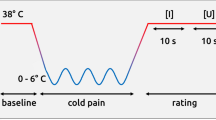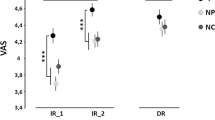Abstract
Thirty-six subjects in a cold pressor experiment were asked to periodically rate the unpleasantness of the experience and estimate the water temperature, under three attention conditions. Subjects were given (1) instructions to monitor their sensations, (2) instructions to monitor their emotions, or (3) no monitoring instructions. With their hands immersed in the cold water, subjects had to learn and later recognize a list of words related in varying degrees to either the sensory or the emotional features of coldness. As predicted, subjects who monitored their sensations rated the experience as less unpleasant, but their estimates of the water temperature did not differ from the other two conditions. In addition, these subjects had a higher rate of “hits” and “false alarms” for words associated with the sensory features of coldness. These results are seen as providing tentative support for the parallel-processing model of pain perception and specifically, the hypothesis that pain reduction can result from a modification of a pain schema.
Similar content being viewed by others
References
Ahles, T. A., Blanchard, E. B., & Leventhal, H. (1983). Cognitive control of pain: Attention to the sensory aspects of the cold pressor stimulus.Cognitive Therapy and Research, 7 159–177.
Barber, T. X., & Hahn, K. W., Jr. (1962). Physiological and subjective responses to pain producing stimulation under hypnotically-suggested and waking-imagined “analgesia.”Journal of Abnormal Social Psychology, 65 411–418.
Blitz, B., & Dinnerstein, A. J. (1971). Role of attention focus in pain perception: Manipulation of response to noxious stimulation by instructions.Journal of Abnormal Psychology, 77 42–45.
Bower, G. H., Black, J. B., & Turner, J. T. (1979). Scripts in text comprehension and memory.Cognitive Psychology, 11 177–220.
Bransford, J. D., & Johnson, M. K. (1973). Considerations of some problems in comprehension. In W. G. Chase (Ed.),Visual information processing (pp. 383–438). New York: Academic Press.
Cantor, N., & Mischel, W. (1979). Prototypes in person perception. In L. Berkowitz (Ed.),Advances in experimental social psychology (Vol. 12, pp. 34–52). New York: Academic Press.
Friedman, M. (1937). The use of ranks to avoid the assumptions of normality implied in the analysis of variance.Journal of the American Statistical Association, 32 657–701.
Gracely, R. H., & Kwilosz, D. M. (1988). The descripto differential scale: Applying psychophysical principles to clinical pain assessment.Pain, 35 279–288.
Groves, P. M., & Thompson, R. F. (1970). Habituation: A dual-process theory.Psychological Review, 77 419–450.
Johnson, J. E. (1973). Effects of accurate expectations about sensations on the sensory and distress components of pain.Journal of Personality and Social Psychology, 27 261–271.
Kanfer, F. W., & Goldfoot, D. A. (1966). Self-control and tolerance of noxious stimulation.Psychological Reports, 18 79–85.
Leventhal, E. A., Leventhal, H., Shacham, S., & Easterling, D. V. (1989). Active coping reduces reports of pain from childbirth.Journal of Consulting and Clinical Psychology, 57 365–371.
Leventhal, H., Brown, D., Shacham, S., & Engquist, G. (1979). Effects of preparatory information about sensations, threat of pain, and attention on cold pressor distress.Journal of Personality and Social Psychology, 37 688–714.
Leventhal, H., & Everhart, D. (1980). Emotion, pain, and physical illness. In C. E. Izard (Ed.),Emotions and psychopathology (pp. 263–299). New York: Plenum Press.
Marchand, S., Bushnell, M. C., Molina-Negro, P., Martinez, S. N., & Duncan, G. H. (1991). The effects of dorsal column stimulation on measures of clinical and experimental pain in men.Pain, 45 249–257.
McCaul, K. D., & Haugtvedt, C. (1982). Attention, distraction, and cold-pressor pain.Journal of Personality and Social Psychology, 43 154–162.
Melzack, R. (1975). The McGill Pain Questionnaire: Major properties and scoring methods.Pain, 1 277–299.
Melzack, R., & Dennis, S. G. (1978). Neurophysiological foundations of pain. In R. A. Sternbach (Ed.),The psychology of pain (pp. 1–26). New York: Raven Press.
Miron, D., Duncan, G. H., & Bushnell, M. C. (1989). Effects of attention on the intensity and unpleasantness of thermal pain.Pain, 39 345–352.
Mower, G. D. (1976). Perceived intensity of peripheral thermal stimuli is independent of internal body temperature.Journal of Comparative and Physiological Psychology, 90 1152–1155.
Posner, M. I., Snyder, C. R. R., & Davidson, B. J. (1980). Attention and the detection of signals.Journal of Experimental Psychology: General, 109 160–174.
Price, D. D., Barrell, J. J., & Gracely, R. H. (1980). A psychophysical analysis of experiential factors that selectively influence the affective dimension of pain.Pain, 8 137–149.
Reading, A. E., Hand, D. J., & Sledmere, C. M. (1983). A comparison of response profiles obtained on the McGill Pain Questionnaire and an adjective checklist.Pain, 16 375–383.
Snyder, M., & Uranowitz, S. W. (1978). Reconstructing the past: Some cognitive consequences of person perception.Journal of Personality and Social Psychology, 36 941–950.
Spanos, N. P., Horton, C., & Chaves, J. F. (1975). The effect of two cognitive strategies on pain threshold.Journal of Abnormal Psychology, 84 677–681.
Taylor, S. E., & Crocker, J. (1981). Schematic bases of social information processing. In E. T. Higgins, C. P. Herman, & M. P. Zanna (Eds.),Social cognition: The Ontario symposium (Vol. 1, pp. 89–134). Hillsdale, NJ: Erlbaum.
Tearnan, B. H., & Dar, R. (1986). Physician ratings of pain descriptors: Potential diagnostic utility.Pain, 26 45–51.
Treisman, A., & Gelade, G. (1980). A feature integration theory of attention.Cognitive Psychology, 12 97–136.
Author information
Authors and Affiliations
Rights and permissions
About this article
Cite this article
Dar, R., Leventhal, H. Schematic processes in pain perception. Cogn Ther Res 17, 341–357 (1993). https://doi.org/10.1007/BF01177659
Issue Date:
DOI: https://doi.org/10.1007/BF01177659




